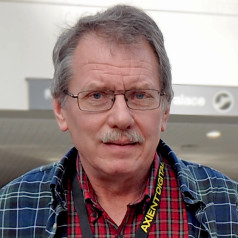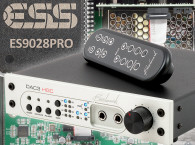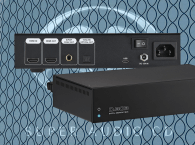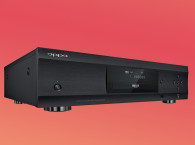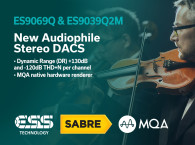The DAC2 series are the latest digital-to-analog converters from Benchmark Media Systems, the American audio manufacturer based in Syracuse, NY. There are three current models, each incorporating the same high-performance digital and analog circuitry, but offering different features and I/O configurations. The DAC2 HGC and the DAC2 L were designed for users who also have analog sources—both include two sets of line-level analog inputs, and have features useful in home theater installations. The HGC version has a headphone amplifier. The L version does not.

Operating Buttons
The model reviewed here is the DAC2 DX, which has been tailored for users who don’t have analog sources or who use a separate analog preamp. The DAC2 DX has six digital inputs—two S/PDIF coaxial, two TOSlink optical, one USB, and is the only DAC in the series that also has an AES/EBU input. The DAC2 DX has two output buses—Main and Aux. The Main output bus feeds one left/right set of RCA outputs and the XLR balanced outputs; the Aux bus feeds the other RCA outputs. Each bus can be separately configured as a variable output controlled by the front-panel volume control, or as a fixed, calibrated output. The Mute and Dim buttons on the front panel are normally used to completely mute all outputs, or reduce the output volume levels by 20 dB. But, if the Mute button is held for 10 seconds, the Main output bus goes into the fixed calibrated mode, bypassing the front-panel volume control. The Dim button functions the same way for the Aux output bus—illumination of the M and A LEDs indicate that those buses are now in the Calibrated mode. This is the preferred mode if the DAC2 DX is used with a separate preamp; the need to hold the Mute and Dim buttons for 10 seconds ensures that the Calibrated mode can’t be selected accidentally.
The Power button on the front panel toggles the DAC2 DX on and off, and two additional buttons cycle the unit through the various digital inputs. LEDs corresponding to the six digital inputs indicate which option has been selected. A steady light indicates a proper digital lock, and a flashing light indicates an improper digital input or the absence of one. Four LEDs indicate the input sampling frequency—they are labeled 44, 48, 2X, and 4X and accommodate all four standard pulse code modulation (PCM) sampling rates from the 44.1-kHz CD standard through 192 kHz. Two additional LEDs indicate the incoming word length, either 16 or 24 bits. The DAC2 DX also accepts Direct-Stream Digital (DSD) data, indicated by illumination of both the 2X and the 4X LEDs.
Two headphone jacks are also located on the front panel. In addition to the digital input and analog output connectors, the rear panel also has a 3.5-mm 12-V trigger I/O jack. This jack can either be used to power up the DAC2 DX from an external 12-V trigger, or it can supply a 12-V trigger to other pieces of equipment when the power is turned on with the front-panel button. Other Benchmark products, including the AHB2 power amplifier, use this same system, so they can be turned on using a trigger voltage supplied by the DAC2 DX, or vice versa.
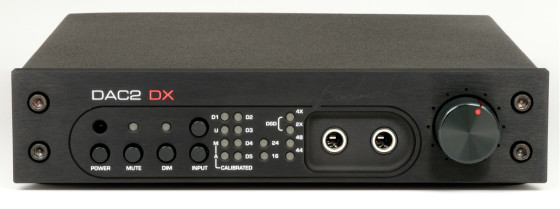
New Design
The DAC2 series has replaced the older DAC1 products, and the changes are not mere functional upgrades. The DAC2 is an entirely new design reflecting significant advances in digital hardware and Benchmark’s formidable design expertise. The new features included in the DAC2 converters include:
- Native DSD Conversion
- Asynchronous USB supporting V. 1.1 and V. 2.0
- Volume-control bypass
- S/PDIF digital pass-through
- Word-length display
- Sample-rate display
- Bi-directional 12-V trigger
- More flexible I/O connectivity
The USB input supports the 1.1 standard of 96 kHz/24 bits without any driver. The Multi-Mode Asynchronous 2.0 standard supports PCM at up to 192 kHz/24-bit, and DSD following the DoP 1.1 standard. A driver is required for this mode on Windows computers, and is downloadable from the Benchmark website; no driver is needed for Mac OS X. DoP 1.1 is a method for transmitting DSD data streams over an S/PDIF interface, and has been adopted by a number of manufacturers of digital audio servers. The S/PDIF and AES/EBU inputs also accept DSD over DoP 1.1, along with PCM up to 192 kHz/24-bit. The TOSlink optical input supports only PCM, up to 96 kHz/24-bit. The DAC1 incorporated a superb jitter-suppression system that Benchmark called UltraLock. This has been upgraded to UltraLock2 in the DAC2 series. All DAC2 converters support the Red Book de-emphasis standard, which is important to those of us who have early CDs with pre-emphasis.

Hardware Details
In the DAC1 USB all the digital inputs were routed through AKM Semiconductor’s AKM4114 Digital Audio Interface, and from there to Analog Devices’ AD1896 High-Performance Asynchronous Sample Rate Converter via the I2S bus. In the DAC2 converters these two chips are replaced with a single Texas Instruments/Burr-Brown SRC4392 High-End Combo Sample Rate Converter. Quoting from the manufacturer’s description:
“The SRC4392 is a highly-integrated CMOS device designed for use in professional and broadcast digital audio systems. The SRC4392 combines a high-performance, two-channel, asynchronous sample rate converter (SRC) with a digital audio interface receiver (DIR) and transmitter (DIT), two audio serial ports, and flexible distribution logic for interconnection of the function block data and clocks. The DIR and DIT are compatible with the AES3, S/PDIF, IEC 60958, and EIAJ CP-1201 interface.”
This chip supports up to eight digital inputs and represents the state-of-the-art in sample rate conversion. It also forms the basis for Benchmark’s UltraLock 2 jitter suppression, which delivers performance superior to two-stage PLL (phase-locked loop) systems.
The DAC1 resampled all digital inputs to 110 kHz, but the DAC2 series upsamples all incoming data to 210.9375 kHz. John Siau, Benchmark’s Director of Engineering, explained: “This upsampling shifts the ESS interpolation filters out of the audio band, and we replace them with improved filters. The upsampling also provides near-perfect rejection of jitter on all of the digital inputs… jitter-induced sidebands never exceed -140 dBFS. This means that jitter-induced distortion is virtually non-existent and if any exists, it is well below audibility.”
The heart of the DAC2 DX is ESS Technology’s ES9018 Sabre32 D/A converter chip, which continues to gain favor with digital converter manufacturers (this chip is also used in the OPPO BDP-95 and BDP-105 universal players). The ES9018 is an eight-channel, 32-bit device. Various manufacturers of converters and stand-alone players have their own approaches to making use of the multiple channels. Benchmark parallels three sections each for the left and right Main outputs. The remaining two channels are used for the left and right Aux outputs. Since the HGC and the L DACs don’t have separate Main and Aux buses, four sections of the ES9018 are paralleled for each channel in those versions. I asked Siau if having only three ES9018 sections in parallel reduced the performance of the DX version compared to the HGL and L version. He commented: “In theory, every doubling of the channel count improves the SNR by 3 dB. Summing two channels to one produces a maximum improvement of 3 dB. Summing four channels to one produces a maximum improvement of 6 dB. Summing three channels to one produces a maximum improvement of 4.8 dB. In theory the difference between summing four channels and summing three channels should be 1.2 dB. In reality the difference is much less than this because the noise of the I-V converters and output stages must be factored into the equation. We boosted the output level of the internal signal path by 2 dB to recover all of what was lost by summing three channels instead of four. For this reason, the SNR of the DAC2 DX is virtually identical to that of the DAC2 HGC.”
Benchmark also uses the ES9018’s internal 32-bit volume control for output level adjustment. In the DAC2 DX a single potentiometer controls the output level entirely in the digital domain.
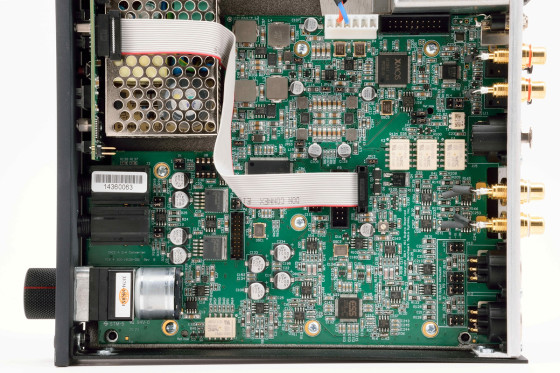
No ES9018 Shortcuts
Siau commented on the shortcuts that some manufacturer’s take when implementing the ES9018 DAC chip: “There are many ways to reduce the cost of using an ES9018 converter. The ES9018 support components can be significantly reduced relative to what can be seen in the DAC2. These cost-saving measures usually degrade the performance of the ES9018. Benchmark’s focus is always on achieving maximum performance, so we have not implemented any of these common cost-saving measures. Instead, we have gone the other way and have added significant refinements to the circuits suggested by ESS. Some of these enhancements are focused on improving the voltage reference input to the ES9018. We actively filter and buffer the reference voltage input, and control it with a precision regulator. This reduces distortion and noise, and provides a stable and predictable output level. Two LME49860 devices and a precision voltage reference are used for this task. This reference circuit also includes 16 additional passive components. Our entire reference circuit could have been replaced by a pair of resistors, but our goal was performance.”
He added, “Many competing products omit the current-to-voltage converters, the differential amplifiers, the analog low-pass filters, and the voltage reference in order to reduce costs. Replacing the LME49860 op amps can also generate significant cost savings. For these reasons, there are huge variations in the performance of ES9018 equipped DACs. The ES9018 is the best D/A converter IC available, and Benchmark has worked hard to extract every bit of performance from the component.”
USB I/O is performed by an SMSC USB3318 High-Speed USB transceiver. An XMOS programmable microcontroller controls the asynchronous USB functions (the XMOS chips are also used for asynchronous USB input functions by OPPO in its BDP-105 player, and by PS Audio in its NuWave, PerfectWave, and DirectStream DACs). Most of the digital signal processing is performed by a Xylinx Spartan 6-series field-programmable gate array (FPGA) chip. With any programmable chip, each manufacturer will normally tailor the programming to meet its own needs and performance specifications. Benchmark’s Multi-Mode Asynchronous Advanced USB Audio has been designed to eliminate jitter-induced distortion. As the owner’s manual explains: “The DAC2 has a low-jitter master clock which controls the transfer of audio data from the computer to the USB sub-system. The computer asynchronously transfers audio data to a buffer in the DAC2. The contents of the buffer are then asynchronously transferred to the D/A conversion sub-system. This second asynchronous transfer eliminates any traces of jitter that accumulate as the data is transferred between the USB and conversion subsystems. No traces of jitter-induced distortion are measurable to our measurement limits (better than -140 dBFS).”
Benchmark claims that its USB implementation offers the convenience of computer playback without the usual compromises.
Intersample Overs
One issue that has been getting some attention lately is intersample clipping, also called “intersample overs.” When audio is sampled, it’s possible for the A/D conversion process to miss peaks that occur between samples. Those peaks are often more than 3 dB higher than 0 dBFS (dBFS means deciBels Full Scale, which is the maximum allowable digital recording level before clipping). When the audio is reconstructed in the D/A conversion process, the missing peaks result in clipping in the reconstructed waveform. Siau explained how Benchmark addresses this often-overlooked problem: “We scale the input signal down by 3.5 dB before applying any filtering or sample rate conversion processes. This prevents clipping in the SRC, and the ES9018. Normally, intersample overs cause overflow problems in fixed-point SRC devices and this normally gives them an undesirable sonic signature. Our technique makes the SRC process transparent.”
“We also feed the ESS DAC chip at –3.5 dB. The ES9018 will clip in response to intersample overs. Our technique entirely prevents this clipping. The only tradeoff is that our SNR is 3.5 dB lower than it would be without the extra DSP headroom. The DAC2 is capable of a SNR of 129.5 dB, but we ‘throw away’ 3.5 dB to avoid intersample clipping (yielding the published SNR of 126 dB, A-weighted). Sonically, this is a very good tradeoff. Intersample overs can reach 3.01 dB over 0 dBFS, so our 3.5 dB of headroom has us covered. It is important to understand that the clipping caused by intersample DSP overloads usually causes non-harmonic distortion that splatters across the entire audio spectrum. Avoiding digital signal processing overloads due to intersample overs is a really big deal.”
Because of Benchmark’s low-noise voltage reference and I/V conversion circuits mentioned earlier, the DAC2 is much quieter than most other products using the ES9018, even with the 3.5 dB reduction in S/N required to prevent intersample overs.
Benchmark’s website has two short articles by Siau that I highly recommend: “Audio That Goes to 11” and “Why Audio Goes to 11.” There’s also a link to a very amusing video that you should watch. The clip is from the 1984 film This is Spinal Tap, in which rock guitarist Nigel Tufnel (played by Christopher Guest) explains to director Marty DiBergi (played by Rob Reiner) how all of the controls on his “very special” Marshall amplifier are calibrated from 0 to 11, rather than the normal 0 to 10. The ability to “go to eleven” allows the amp to give a little “extra push” if you need it. (Even the tone controls “go to eleven;” after all, you would never want less of something—only more!). This is all very tongue-in-cheek, of course, but if 10 represents normal digital zero, intersample overs will create clipping in the conversion process. Benchmark’s technique enables the DAC2 to “go to eleven” without distortion.
Siau also commented on the effect the sampling rate has on intersample overs: “Low sample rate recordings (CD and 48 kHz audio for video) are prone to having problems with intersample overs. In contrast, high sample rates rarely have intersample over problems because there is very little audio energy at the frequencies where the worst-case intersample overs occur. The worst case occurs at Fs/4. For a CD this is 11.025 kHz. There is often enough short-term energy near 11 kHz to create issues. At a 96 kHz sample rate, the worst case intersample over occurs at an audio frequency of 24 kHz (where there is much less audio energy). For this reason, high sample rates tend to significantly reduce the intersample over problem”
Siau added, “One might suggest that upsampling 44.1 to 96 kHz (or higher) would solve the problem. Actually the reverse is true. Intersample overs are exposed to clipping while upsampling. When upsampling filters clip, the resulting distortion products splatter across the entire audio band. Given this information, one might suggest that 44.1 kHz should never be upsampled. Unfortunately, all modern D/A converters upsample. Modern oversampled 1-bit and multi-bit converters have brought many significant improvements to digital audio, but they have created an intersample clipping problem. Upsampling DSP processors can be designed so that they don’t clip. One solution is to use floating point math. Another solution is to reduce the signal level by at least 3.01 dB prior to processing. We have chosen the second option. The second option is the only option when an SRC or an upsampler has fixed-point PCM inputs and outputs. Our SRC and the ES9018 are both limited to fixed-point operation… The sin(x)/x reconstruction filters in the D/A will reconstruct the intersample peaks provided they fall within the Nyquist limit, and are not clipped by an upsampling DSP process.”
In addition to the other sonic advantages, this is a good reason to make master recordings at high sampling rates, even if the finished product will be a Red Book CD.
Analog Circuitry
The analog circuitry in the DAC1 used TI NE5532 op-amps as I/V (current-to-voltage) converters, and Texas Instruments/National LM4562 op-amps elsewhere. The DAC2 uses Texas Instruments/National LME49860 chips throughout. I counted a total of 17 of these dual op-amps in the DAC2 DX. This high-performance audio IC features a slew rate of 20 V/µSec, gain bandwidth product of 55 MHz, very low voltage noise of 2.7 nV/√Hz, total harmonic distortion (THD) of 0.00003%, and will operate on up to ±22 V supply rails. The ES9018 has differential current outputs, and Benchmark feeds these to precision differential I/V converters to minimize common-mode distortion. The outputs of the differential amplifiers are AC-coupled with a corner frequency of 0.016 Hz. Siau mentioned that he prefers AC coupling to DC servos, and says that the keys to success with this approach are as follows:
- Set the corner frequency very low (under 0.1 Hz)
- Select good capacitors (Benchmark usually uses at least two different types of capacitors in parallel)
- Manage leakage currents carefully
Signal-routing relays with gold-plated contacts route the signals to the appropriate output buffers and/or the headphone amplifiers. Benchmark notes that the balanced and unbalanced outputs of the DAC2 have very similar performance.
The headphone outputs are driven by a pair of TI LME49600 high-current audio buffers. Judging by the specifications and the simplified schematic diagram in the datasheet, this chip is similar to the Texas Instruments/Burr-Brown BUF634. It’s an open-loop, current-feedback device with a slew rate of 2,000 V/µSec, output current of 250 mA, bandwidth adjustable from 110 to 180 MHz, and is designed to be used with an op-amp inside the feedback loop. The LME49600 has been designed especially for high-performance audio applications with a THD of 0.00003%, and maximum DC supply voltages of ±20 V (the older BUF634 is limited to ±18 V rails and the THD is not specified for that device). The high output current of the LME49600 buffers enables headphones to be directly driven—no series output resistor is used, yielding a 0-ohm output impedance. Most headphone amplifiers have some resistance in series with the outputs, which is usually at least 10 Ω and often higher with circuits based on unbuffered op-amps. Since headphones don’t have flat impedances curves, the series output resistor alters the frequency response and degrades the damping factor. Benchmark’s design is the best possible solution for headphone amplification.
As with all new Benchmark products, the DAC2 DX has a switching-mode power supply. Benchmark has found that the elimination of the power transformer’s hum field, combined with placing the switching frequency well above the audio band, results in lower noise than a linear supply. Benchmark also uses choke filtering at the output of the switching supply—there are eight chokes, four at 15 µH and four at 2.2 µH, used in conjunction with first-stage regulators. They also use generous local regulation—at least one dedicated, low-noise voltage regulator is used for each critical subsystem.
Internal Jumpers
The DAC2 cover is held in place with eight small Phillips machine screws and is easily removable, allowing access to several user-configurable jumpers on the PC board. To accommodate headphones with varying sensitivities, the headphone amp gain can be set to three levels: 0 dB, –10 dB, or –20 dB. The factory default is 0 dB. As shipped, the main output bus will mute when headphones are plugged into the left-hand jack. Jumpers enable the user to apply this to the right-hand jack, both, or neither. There’s no industry standard for gain and input sensitivity on power amplifiers. Ideally, a normal listening level should be achieved with the preamp’s volume control near the 12:00 position, but many power amps are designed with gain set too high to allow this. The XLR outputs on the DAC2 are equipped with low-impedance passive pads to reduce the output level when the unit is used with high-gain power amps. As shipped, the pads are disabled, which sets the output level at 0 dB. Jumpers enable the pads, allowing attenuation of –10 dB or –20 dB. At 0 dB output, the XLR jacks have an output impedance of 60 Ω (30 Ω for each leg). Setting the pad to –10 dB or –20 dB increases the output impedance to 425 Ω or 135 Ω, respectively. But Benchmark notes that the dynamic range is not affected. This will affect the maximum cable length that the DAC2 can drive without degrading high-frequency performance, but even with the worst-case 10 dB pad, cables up to 96’ can be used with only a 0.1 dB loss at 20 kHz.
Two additional jumpers enable the Digital Pass-Through mode. This converts RCA connector D5 from a digital input to a buffered digital output. With the Digital Pass-Through mode enabled, the data from any selected digital input—whether USB, S/PDIF, AES-EBU, or TOSlink—is passed to connector D5. This can be especially handy for digital format conversion, or for connecting a second DAC2 as a slave. Benchmark notes that the Digital Pass-Through is bit-transparent—the data is actively buffered but is not rewritten or modified in any way.

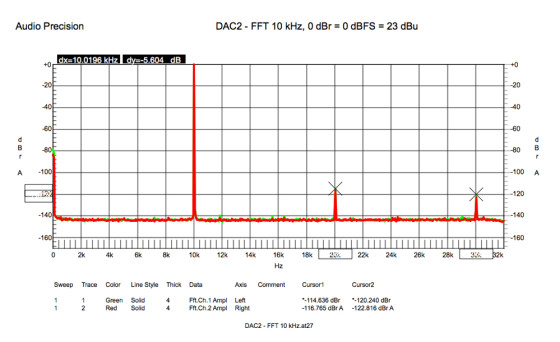
Measurements
Benchmark supplied several performance graphs that I requested, which show the DAC2 DX’s measured performance to be state-of-the-art. Figure 1 shows the total harmonic distortion-plus-noise (THD+N) at maximum output level, 20 Hz to 20 kHz, with an 80 kHz low-pass filter, at the balanced outputs. THD+N is a very low –105 dB, with virtually no rise at high frequencies. Figure 2 shows a Fast Fourier Transform (FFT) analysis of a 10-kHz sine wave at maximum level, which is an excellent test for detecting sample clock jitter. The measurement limit of the Audio Precision 2700 is –140 dB, and shows no evidence of jitter-induced sidebands to the measurement limit of the test equipment. The harmonic distortion produced by the DAC2 DX is extremely low: –114 dB left and –116 dB right at 20 kHz, and –120 dB left and –122 dB right at 40 kHz. These numbers indicate excellent slew rates in the analog circuitry, and are similar to those shown in Benchmark’s 1-kHz FFT. Figure 3 shows intermodulation (IM) distortion using 11 kHz and 12 kHz tones. The 1-kHz difference tone is at –122 dB, while the 10 kHz and 13 kHz distortion products are an –128 dB, which is extremely low by any criteria. Benchmark has many more performance graphs, plus a complete list of specifications in the owner’s manual, available as PDF download from its website. I measured the de-emphasis accuracy using my own De-Emphasis Test CD and an Agilent 34401A DMM, and found both channels within ±0.06 dB, 20 Hz to 20 kHz.

Listening
I had the DAC2 DX in my system for about three weeks. For most of that time, I was also using Benchmark’s AHB2 power amp. I used the DAC2 DX with its balanced outputs in variable mode connected directly to the AHB2. More recently, I purchased a unit from Benchmark and am using it in the calibrated mode with my own preamp and Monarchy SE-100 Deluxe MkII mono amplifiers. The digital source is an OPPO BDP-105 connected via S/PDIF. I used the same CDs and high-resolution PCM sources that I listed in my review of the AHB2 (audioXpress April 2015). In my favorable review of Benchmark’s DAC1 USB, I noted its excellent inner detail, spacious and precise soundstage, and sonic presentation that emphasized accuracy rather than euphonic coloration. My one criticism was that the tonal balanced leaned toward a slight brightness. Although there are several factors that could cause this, I attributed it to the 5532 I/V converters.
The sonic performance of the DAC2 DX is in an entirely new league when compared to the DAC1 (I still have a DAC1 USB available for comparison). First, the tonal balance is extremely neutral, without any of the DAC1’s brightness. The DAC2 DX also has a harmonic richness which, by comparison, I find somewhat lacking in the DAC1. This is especially impressive on well-recorded strings, such as the Mercury CD of Ottorino Respighi’s The Birds, and is not a result of the addition of euphonic coloration. Like all Benchmark products, the DAC2 DX has been designed for maximum accuracy, and what it does better than the DAC1 is simply a matter of getting more information off of the digital source, while adding very little sonic character of its own.
In my review of the AHB2, I commented on its “jaw-dropping” level of detail and resolution. The DAC2 DX is a worthy match for the AHB2 in that regard. Using the DAC2 DX with my own preamp and power amps gives my system a new level of detail and transparency. It doesn’t equal the level of performance I experienced with the AHB2, but the DAC2 DX alone gets my system about half way there. The transient performance of the DAC2 DX is exceptional. I can’t say that I’ve ever been aware of intersample overs on CDs in my collection with other digital playback hardware (which is not to be confused with the hard clipping on some discs), but the DAC2 DX is exceptionally clean on transients. The DAC2 DX’s soundstage reproduction is superb, and considerably more precise than the DAC 1, especially localization of instruments and ambience retrieval in the rear of the soundstage.
The DAC2/AHB2 combination will do nothing to flatter a recording or transfer made with dated digital technology. Unfortunately, every digital reissue of the classic Solti/Decca recording of Richard Wagner’s Der Ring des Nibelungen is based on Decca’s 1984 digital transfer because the original analog tapes have deteriorated beyond usability. Not even the latest Blu-ray remastering can conceal that reality, and the DAC2 DX simply tells the truth, for better or worse.
Since I reviewed the OPPO BDP-105 in audioXpress, I’ve been searching for a reasonably-priced D/A converter that will actually improve the OPPO’s performance as a stand-alone player. That hasn’t been an easy task. The BDP-105 remains my reference digital player and continues to offer performance that is simply amazing at anything close to its $1,200 cost. Over the past two years I’ve reviewed some affordable D/A converters that have offered excellent performance in their price classes, especially the Parasound Zdac and the PS Audio NuWave. The NuWave, which retails for $995, came the closest. In my review I wrote: “The PS Audio NuWave DAC offers a slight improvement (over the BDP-105) in soundstage size and localization. The low-order THD added by its discrete output circuitry provides a harmonic richness that is musically extremely engaging. In other areas, (e.g., tonal balance, high-frequency smoothness, and detail), I prefer the BDP-105.”
The Benchmark DAC2 DX is a hands-down improvement over the OPPO as a stand-alone player, especially in the areas of inner detail, soundstaging, high-frequency airiness, and bass. The extreme low end is both deeper and better controlled than the OPPO. Dynamics, across the spectrum, are excellent. The DAC2 DX doesn’t offer the slight euphonic coloration that many listeners will find appealing about the NuWave. Benchmark’s goal in all of its products is ultimate precision and accuracy, and the DAC2 DX tells the truth about every source it’s fed, while being free of unmusical artifacts sometimes associated with digital audio.
One of my frustrations is how the recording industry has prevented Super Audio CD (SACD) and Blu-ray customers from getting the most out of these potentially-excellent formats. I have my OPPO BDP-105 player set so the S/PDIF digital output will deliver the full resolution of all PCM media, up to 192 kHz/24 bit. To my extreme annoyance, all the Blu-ray audio discs that I own force the OPPO to down-convert high-resolution discs to 48 kHz/16 bit at the digital output. I realize that this is done to prevent piracy, but the recording companies are also preventing users of outboard DACs from fully realizing maximum performance from these discs.
Since the DAC2 DX will accept DSD datastreams, it has the potential of delivering improved performance from SACDs. But, there’s no way to get a DSD datastream out of any SACD player, as far as I’m aware, except via the HDMI connection. To add HDMI capability to a product, a manufacturer must pay an annual fee of $10,000 per year, which is prohibitive for most small audio companies. Bryston recently announced its new BDA-3 D/A converter, which has two HDMI inputs that will accept a DSD datastream from SACD players. The projected list price is $3,200, about $800 more than its current BDA-2 converter. Several websites have noted Bryston’s unveiling of the product at the 2015 Consumer Electronics Show (CES).
In the OPPO review, I also mentioned the Bricasti M1 as being the finest digital audio I’ve heard in my system. That remains the case, and Bricasti has made further improvements to that amazing product since I auditioned it about two years ago. The M1 that I heard simply offers a level of spaciousness and harmonic richness that I’ve never heard from any other digital playback equipment. But, the Bricasti now sells for $8,995, well out of the reach of most audiophiles. The law of diminishing returns is definitely in play, and the DAC 2 DX gets you three-quarters of the way there for less than a quarter of the price. The Benchmark DAC2 DX is a reference-quality D/A converter, which I am now delighted to have in my own system.

DAC2 DX Stereo D/A Converter
Benchmark Media Systems, Inc.
203 East Hampton Place, Suite 2
Syracuse, NY 13206
800-262-4675
www.benchmarkmedia.com
Price: $1,895 without remote control; $1,995 with remote
Resources
DoP 1.1, www.dsd-guide.com/dop-open-standard
G. Galo, “A De-Emphasis Test CD,” audioXpress, February 2009.
______, “Benchmark AHB2 Stereo Power Amplifier,” audioXpress, April 2015.
______, “Oppo BDP 95 Universal Network 3-D Blu-ray Disc Player,” audioXpress, Janurary 2012.
______, “Oppo Digital’s New 3-D Blu-ray Disc Player Raises the Bar,” audioXpress, October 2013,
www.oppodigital.com/blu-ray-bdp-105/blu-ray-BDP-105-Review.aspx.
______, “Benchmark DAC1 USB,” audioXpress, January 2009.
______, “Wagner: Der Ring des Nibelungen” (Soloists and Vienna Philharmonic Orchestra conducted by Georg Solti), Association for Recorded Sound Collections (ARSC) Journal, Issue 1, 1998 (CD edition, Decca 455 555-2); Issue 2, 2010 (SACD edition, Esoteric/Decca ESSD 90021-34); Issue 2, 2013 (CD/Blu-ray edition, Decca 0289 478 3702 2).
______, “Parasound’s New Zdac,” audioXpress, July 2013.
______, “PS Audio NuWave DAC,” audioXpress, August 2013.
C. Hansen, “Measurements for the Benchmark DAC1 USB,” audioXpress, January 2009.
J. Siau, “Audio That Goes to 11” (the link to the video is on this page).
______, “Why Audio Goes to 11”
Sources
Bricasti M1 | www.bricasti.com
Bryston BDA-3 | www.bryston.com
ESS 9018 DAC chip - ESS Technology | www.esstech.com
HDMI Fees www.hdmi.org/manufacturer/terms.aspx
BDP-105 Digital Player - OPPO Digital | www.oppodigital.com
Zdac D/A Converter - Parasound | www.parasound.com
NuWave D/A converter - PS Audio | www.psaudio.com
SRC4392, LME49860, and LME49600 Digital audio interface - Texas Instruments | www.ti.com




